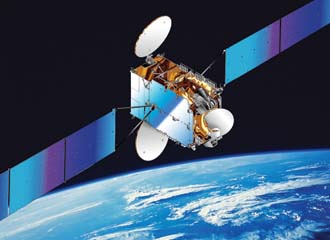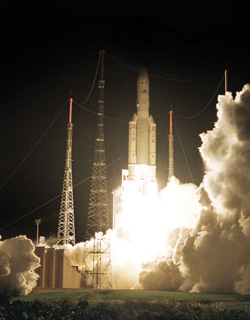Brazil Develops Satellite Communications Road Map
 |
The Star One C1 satellite is one of Brazil’s two main orbital relays for military communications. The equatorial South American country is expanding its use of satellites for communications and other military support functions. |
Brazil is looking skyward to provide secure communications necessary for its military forces. Using SISCOMIS, the country’s national System for Military Satellite Communications network, Brazil is turning to satellite communications to play a progressively larger role in its joint military structure. Recent initiatives are seeing new terminal procurement, further hubs and two additional satellites that would join recently launched orbiters beginning in 2014. Brazil also is employing international government-to-government cooperation with France to access advanced military satellite communications technology and capabilities.
Satellite communications (SATCOM) implementation is a natural answer to the challenges posed by the country’s natural geography, says Lt. Col. Luciano Menna, military SATCOM operations manager, Command and Control Chief Office, Brazilian Ministry of Defense. “Brazil is a very large country,” he points out. “Our land border comprises more than 16,000 kilometers, and we have problems involving drugs and arms smuggling, and we have much to protect. Our seashore is vast [nearly 7,500 kilometers], and we also have a large EEZ [exclusive economic zone] of 3.6 million square kilometers to take care of.”
The core of Brazil’s SATCOM capability is based on supporting the Brazilian Command and Control Military System, or SISMC2, Col. Menna notes. “In order to maintain effectiveness in military command and control in such a huge country, a comprehensive communications network was required that must include satellite-based defense missions. The Brazilian Command and Control Military system is a [collection] of capabilities, equipment, communication processes and personnel [and is] essential for commanders at the national level in crises and conflicts. The Ministry of Defense and its staff are responsible for the operation of the system, including links with the Joint Operations Center and both permanent and temporary C2 [command and control] centers,” he explains.
The SISMC2 has at its apogee the Ministry of Defense Command and Control Center (COC) with permanent links to the Aerospace Defense Command’s COMDABRA system, the air force’s COGAR, the navy’s CCTOM and the army’s CC2FTER command and control systems. In addition to permanent links, the SISMC2 is designed to be reconfigured as required to establish temporary links to an operational U.N. theater command for peacekeeping forces, such as the U.N. Stabilization Mission in Haiti, or MINUSTAH.
The bearer network for these links is the overarching SISCOMIS program, initially created in 1984 as a solely terrestrial-based telephone network. It links more than 380 military organizations and about 1,600 telephone numbers. A satellite-based solution was added in 1992 with the advent of C-band communications, and in 2000, X-band options were added.
“Eventually this has becomes the backbone for the defense operational network growing from the original telephone network to IP [Internet protocol]-based networks,” Col. Menna says. “It is a combination of ground-based and satellite-based networks with terrestrial links and robust X-band and Ku-band links. The ground segment has two X-band hubs, and we use the main terminal types—flyaway, maritime and towable. We use Star One C1 and C2 satellites with the earth station located within our territory.”
These communications are supported by a number of domestic firms—Star One, a subsidiary of Embratel and Brazil Telecom—as well as overseas participation from Indra and Elbit Systems. The C1 and C2 satellites were launched in 2007 and 2008. The C1 was launched from French Guiana on the same Ariane 5 heavy-lift launcher as the United Kingdom’s Skynet 5B military SATCOM satellite. It supports C band and Ku band with a single X-band transponder using a Thales Alenia space-sourced Spacebus 3000 B3 platform.
The current systems consist of a ground-based network with the SATCOM linked via two domestic X-band hubs. Users have access to three types of terminals: flyaway, maritime and towable. Typically the towable terminals would equip forces at the joint command level with 1.8-meter flyaways at the component force level and 1.2-meter systems at the brigade level and below. In May 2009, Brazil acquired the Rockwell Collins SWE-DISH suitcase CCT120 quad-band Ku-, Ka-, X- and C-band flyaway terminals. In June 2011, Indra announced that it was supplying new flyaway SATCOM systems, having previously supplied both terrestrial and maritime terminals.
 |
An Ariane rocket launches Brazil’s Star One C2 satellite into orbit. Brazil plans on adding a new generation of military communications satellites that will be built by a company jointly owned by aerospace giant Embraer and Brazil Telecom. |
“Joint operations are not the only ones where we employ military SATCOM,” Col. Menna says. “Brazil will host a [major] sporting event almost every year to 2016, including the FIFA Confederations Cup, FIFA World Cup and the Olympic Games. Military SATCOM will be required in every one of them.”
The systems provided support to the 5th CISM Military World Games in 2011 by working through the Brazilian Military Sports Commission (CDMB), establishing links between that body as well as the Joint Operations Integration Center (CIOS). This effort used flyaways at the main and alternative centers and back to the CDMB as well as to the joint operations center via the army’s intranet.
In extending its capabilities, Brazil is looking at international partnerships. The rationale for this is simple, Col. Menna explains. “We don’t have so much experience in the space sector, so we must learn from other countries who have more experience.”
This has led to cooperation between Brazil and the French Ministry of Defense with a recent military SATCOM test late last year. Col. Menna explains that, “Between October 25 and November 4, we performed a test in X band using one Syracuse III satellite from a flyaway [terminal] in Brazil to a maritime terminal on a [Brazilian navy] frigate near Africa. That was part of an international partnership with France that both parties are evaluating. The results have shown good possibilities, which will be shared by both countries. If this partnership goes further, it will be helpful for our navy in the first approach.”
Discussing how further cooperation with the French Ministry of Defense could develop, Col. Menna says, “One expectation we have is that our maritime [assets] will be able to access Syracuse satellites so that we can directly use their transponders to link our ships to Brazil without using their ground station. That was the test. We will get global reach after this.”
Addressing other modernization efforts, Col. Menna comments, “We have taken some [additional] measures to increase our capabilities. According to the Armed Forces Joint Chief of Staff recommendation, we [will] rely a little more on X-band terminals, and we will increase the use of Ku-band terminals and implement a Ku-band hub [this year].”
For the future, the Brazilian military anticipates increased use of X band and Ku band. Studies on the use of Ka band currently are underway. Terminal procurement is prioritizing X-band manpack systems and X- and Ku-band maritime terminals, as well terminal options for implementations with Ka-band feeds.
Discussing mobile options, Col. Menna says, “We are interested in SATCOM on the pause for emergency and natural disasters and military options, but not SATCOM on the move at this moment.”
The Ministry of Communications and the Ministry of Defense have an agreement to provide government SATCOM systems support for X band and Ka band, with the first satellite to be launched in 2014 and the second in 2019. To coordinate this, a company has been created under Embraer. The initial launch date, which represents a difficult schedule to meet, has been set by a presidential decision. “We have a team working hard on that,” Col. Menna comments.
SATCOM capabilities, both legacy and future, are being integrated into new command, control, communications, computers, intelligence, surveillance and reconnaissance (C4ISR) systems being fielded by the three military services. The most significant two near-term systems are for the army and navy. The army’s SISFRON program will provide surveillance along the country’s western border, including the Amazon region, with links from the land forces command and control center down to a regional center or area military commands and then through echelons of command from brigade down to border special platoons and patrols. The navy’s key near-term implementation will be SISGAAz, which is a Portuguese acronym for Blue Amazon Management Systems. This will bring in a range of surveillance capabilities. In addition to military SATCOM, SISGAAz also will integrate satellite-based radar as well as terrestrial-based long-range identification and tracking, automatic identification system and vessel traffic service. The Air Force also is looking at military SATCOM operation for airspace control and defense.
Beyond SATCOM satellites, Brazil also has plans for a family of satellites in low and medium earth orbit for weather monitoring and imaging.




Comments